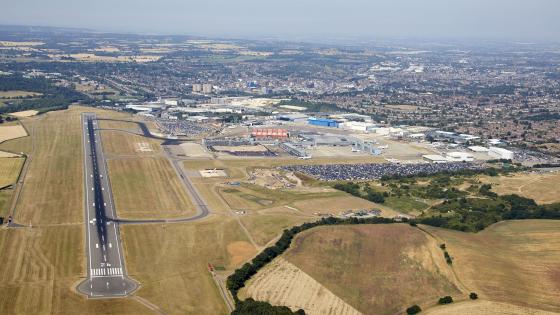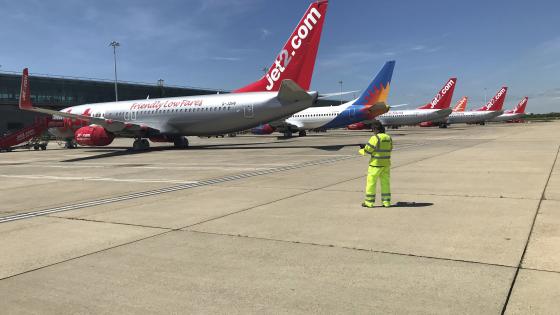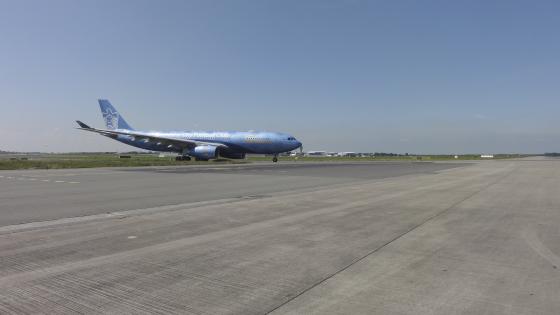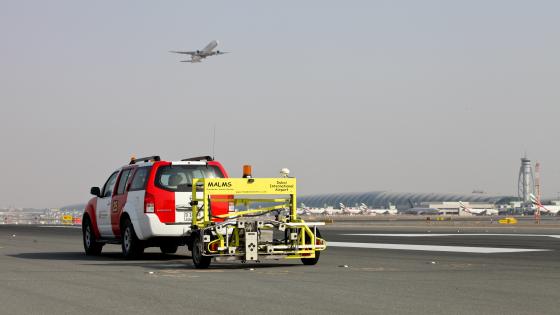Airport operators need to keep their runways in prime condition all year round, whatever the weather. Mark Broadbent reports on the technologies and materials helping them
The impact of climactic extremes on airport infrastructure was obvious in July 2022, when record high temperatures in the UK caused damage to the runway at London Luton Airport. With the mercury on the thermometer rising above 37ºC, a small section of asphalt became so hot that it de-bonded and began to lift. The runway was closed for two hours while a repair was carried out, leading to departure cancellations and arrival delays.
Bachar Hakim, director of roads asset management at infrastructure consultancy AECOM, told Airports International: “Runways are the most valuable airport assets. This is particularly the case for single runway airports, such as most UK facilities. They must be maintained in a safe and sustainable condition throughout their entire lifecycles to provide continuous operation. Premature failure can lead to unexpected repairs and traffic delays, negatively impacting an airport’s costs and reputation.”
With the recent increase in temperatures and intensity of rainfall, climate resilient infrastructure should also be considered in [runway] design

In 2022, a small section of asphalt on LLA's runway became so hot it de-bonded and began to lift
Effective surfaces
Hakim outlined the issues facing airports: “Runway pavements are designed to provide a durable structure with appropriate surface friction to carry aircraft loading and account for environmental variations. Pavements can be broadly classified into flexible (asphalt) and rigid (concrete).
“The most effective surfacing solution should be designed to account for multiple parameters, including temperature. Different asphalt mixtures and hydraulically bound materials are used in runway pavement construction, with consideration given to ground condition, traffic loading, environmental variations, materials availability and local construction practices, as well as capital and whole life costs, sustainability and users’ costs in terms of runway availability during maintenance.
“Asphalt mixtures can be specified with appropriate aggregate gradation and binder properties, content and modifications to provide deformation and fatigue resistance. Concrete slabs are commonly used at runway ends to mitigate the risks of asphalt deformation under slow moving/stationary heavy aircraft in hot weather and poor fuel resistance. However, rigid pavements have higher construction costs. With the recent increase in temperatures and intensity of rainfall, climate resilient infrastructure should also be considered in the design.”

The material used in airport runways and taxiways varies from location to location
Temperature change
All asphalt contains bitumen, a by-product of refined crude oil. Speaking to Airports International, Dr Greg White, director of the Airport Pavement Research Program at the Centre for Pavement Engineering Education – part of the University of the Sunshine Coast in Melbourne – pointed out how temperature extremes are not in themselves problematic.
White explained: “If everything is cold all the time, that can be accommodated. If everything is hot all the time, that can be accommodated. It’s when there are big swings from summer to winter that things become difficult, because it’s hard to make a single product that will cover the full spectrum. In my experience, the UK is not that variable from summer to winter. What happened [at Luton] last summer was a bit of an anomaly, I think, and you’re not regularly getting below zero in winter.”
White pointed out that many regions of the world are accustomed to big changes in temperature: “There are parts of North America – Canada is a great example – where they get 35ºC in summer quite frequently and –30ºC in winter. Their swing is far bigger. Australia gets 40ºC in summer, but we rarely get zero in winter.
If you have a few days in a row where things don’t get to cool down and the heat builds and builds, you start to push the envelope
White pointed out that many regions of the world are accustomed to big changes in temperature: “There are parts of North America – Canada is a great example – where they get 35ºC in summer quite frequently and –30ºC in winter. Their swing is far bigger. Australia gets 40ºC in summer, but we rarely get zero in winter.
“Deserts are the other places that have big swings. They have the heat of summer, but they can reach sub-zero in winter because there’s no insulation. Coastal areas usually have lesser swings than inland areas, so because the UK is coastal it's better off in terms of a smaller swing.”
Temperature variance means the appropriate paving material changes depending on an airport’s location. White said: “If you took an Australian pavement and put it in Germany or North America you might get cracks in winter because they’re not engineered for that.”
Even in Australia, though, unusual weather can cause problems: “If you have a few days in a row where things don’t get to cool down and the heat builds and builds, you start to push the envelope.” This applies to all paving in critical transport infrastructure, including roads, not just airport runways.
AECOM’s Bachar Hakim noted: “Two main factors contribute to pavement deterioration: environmental effects and traffic loading. The environmental variations include temperature, which causes asphalt rutting in hot weather and cracking of the age-hardened brittle asphalt, as well as concrete wrapping and thermal cracking. Seasonal changes in foundation condition due to moisture and freeze-thaw action can lead to further damage. The designer should consider the expected temperature and moisture variations at the airport site during construction and life cycle when designing the pavement and materials.”

The most effective surface varies according to parameters such as temperature and traffic loading
BBA and its benefits
In the 1990s, a high-performing asphalt called BBA (béton bitumineux pour chaussées aéronautiques) was introduced in France and has increasingly been used in runway construction in Europe.
Civil engineering firm Colas has used BBA-spec asphalt in various resurfacing projects since 2005, including Manchester, Birmingham, East Midlands, Jersey, the Isle of Man, Southend and Sumburgh airports. In a case study, the contractor identified various benefits of the material: “The coarse surface texture and high friction characteristics of BBA negate the need for grooving, saving time and allowing aircraft [on the surface] as soon as it has been compacted and cooled.
“The material is able to demonstrate the required surface friction characteristics, reduced deformation and fatigue, and offers a longer lifespan than alternative materials. BBA can be laid as binder course due to its high wet friction properties. This enables aircraft to land on a BBA binder course and use it as a temporary operating surface during runway rehabilitation/maintenance work.”
The coarse surface texture and high friction characteristics of BBA negate the need for grooving
BBA can be laid at thicknesses of 15% less than asphalt, so less aggregate is required. Colas said the material has been shown to “produce comparable pavement strength and durability at a reduced layer thickness when used in combination with stiff asphalt base.
“Time and cost savings can be realised as BBA is easier to mix and can be manufactured at far greater output rates than traditional asphalt. Higher outputs also reduce the number of joints which, in turn, lowers whole-life costs. Un-grooved BBA negates the risk of premature groove closures, minimising maintenance requirements.”
However, materials should not be the only runway design/build consideration, according to Hakim: “The designer should consider materials availability, project sustainability, local construction practices and environmental conditions in selecting the pavement type.”
A range of performance requirements – durability, skid resistance, quality control, monitoring and future maintenance – should also be taken into consideration, Hakim stressed, telling Airports International: “The pavement designer should assess solutions for the expected performance, traffic loading and environmental condition, considering sustainability, climate resilience, whole life cost and user’s cost.”

Different asphalt mixtures and hydraulically bound materials are used in runway pavement construction according to ground condition and traffic loading
Data collection
Big data is leading to some potentially exciting new opportunities for asset monitoring. Although still in the relatively early days of its development, eye-catching developments for runways include embedding data monitoring technologies in the surface, using ‘self-healing’ asphalt and concrete, as well as harvesting energy from aircraft friction and using pollution-absorbing materials.
AECOM’s Centre of Excellence for Pavement Asset Management in Nottingham is working on these areas of innovative design to help improve costs and sustainability. The centre has a whole-life approach, encompassing design, specifying materials, quality testing during construction, surveying and monitoring existing pavements to assess performance, asset management, deterioration modelling, treatment prioritisation, and research and development into updating/rewriting design standards.
At Hong Kong Airport, the AECOM team recently developed a stone mastic asphalt specification for taxiways, investigated cracking on the north runway pavement and undertook a feasibility study on the use of reclaimed asphalt pavement materials in runway foundation layers.

Concrete slabs are commonly used at runway ends to mitigate the risks of asphalt deformation under slow moving/stationary heavy aircraft in hot weather
Learning from other sectors
Hakim thinks airports can take on board lessons from other transport industry sectors: “We can learn from the highway industry, where new and innovative asphalt, concrete and composite constructions, low carbon and recycled materials are considered.
“End-product performance specification, commonly used for major highway pavements to ensure the design assumptions are met during construction, can be considered. However, runway performance expectation of durability, friction and safety, such as foreign object debris damage and associated risks, should also be assessed.
“Asphalt pavement with appropriate mix design and polymer modification can offer a cost-effective sustainable solution. Reinforced/unreinforced concrete pavement can offer durable low maintenance, but has high capital/construction cost.”
The Centre for Pavement Engineering Education’s Dr White highlighted the use of recycled materials in asphalt: “Instead of producing from scratch a polymer to put into the bitumen to make it better, you can put in recycled waste plastic to improve its performance, particularly in high temperatures.”

Maintenance should be a key consideration in runway construction, experts say
Epoxy modifiers are another innovation. Dr White explained these are similar to polymers, but rather than using plaster-based chemicals, they use epoxy material. “[They are] good at providing very hard, robust materials,” he said, because they do not have much built-in flex, making them well suited to applications such as bridge decks. They are expensive, but they do extend lifespans so may be something worth considering in the future.
Dr White agrees that future airport paving innovations are likely to follow the lead set by other transport sectors: “Although they don’t carry the same types of loads [as runways], highways have to deal with the same kinds of issues. If the world got so hot that bitumen needed to be changed to function and perform in the way it needs to, that would apply to roads almost equally.
“Even though there are different outcomes and requirements, most of the principles and science of different pavement types would be most likely led by the road and highway people – airports would learn from that.”
